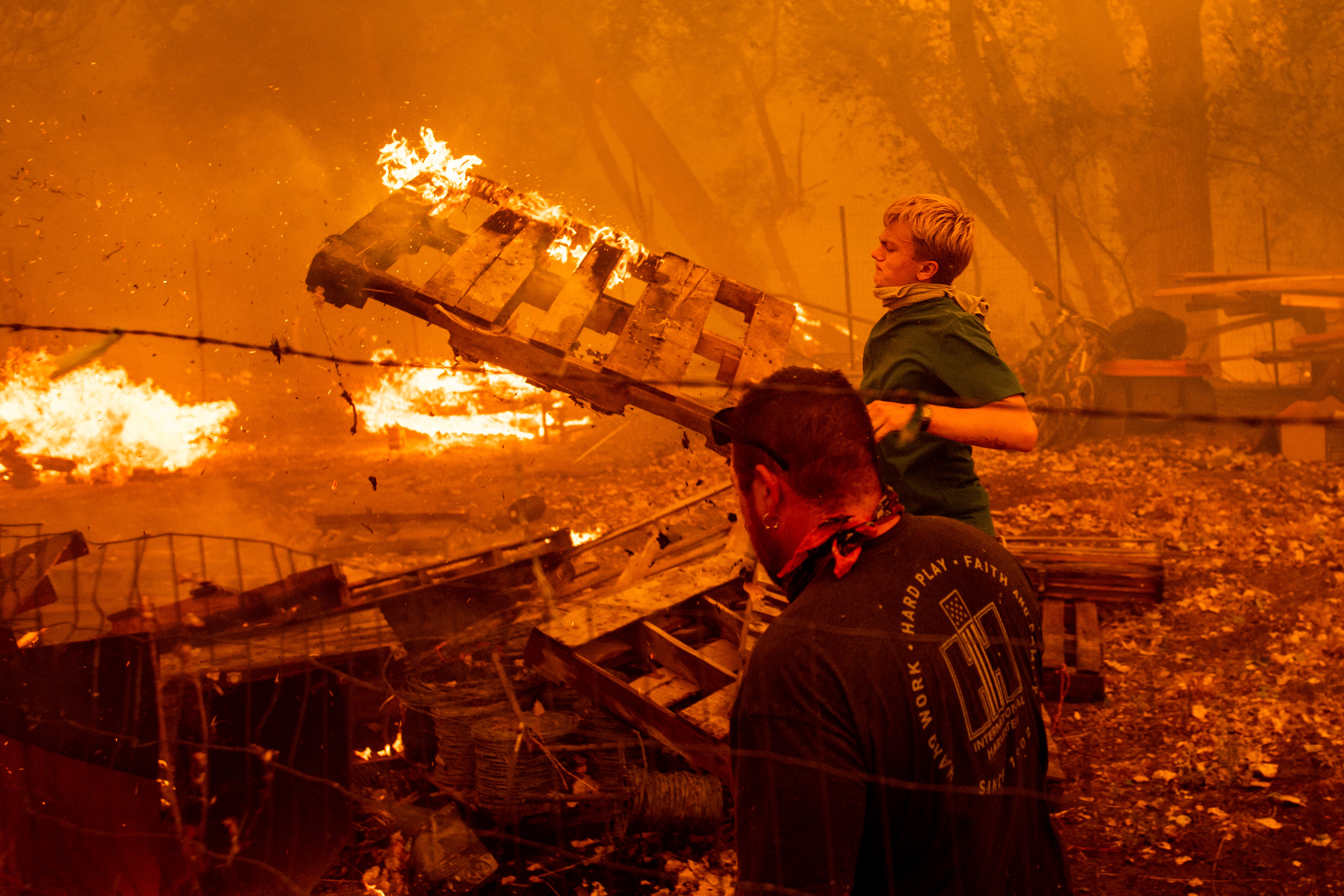California scorched by raging wildfires the size of LA
Alex Schenck, 15, throws flaming pallets while fighting to save his home as the Ranch Fire threatens the town of Clearlake Oaks in northern California (NOAH BERGER)
San Francisco (AFP) – Tens of thousands of firefighters battled relentless flames ripping across California on Tuesday, as the death toll from a series of infernos that erupted last month hit 11.
The raging Mendocino Complex fire comprising twin blazes in the western state’s north has now ravaged more than 290,000 acres (117,359 hectares) — approximately the size of sprawling Los Angeles — in less than two weeks, becoming California’s largest wildfire since record-keeping began a century ago.
Some 14,000 firefighters including reinforcements from as far away as Australia and New Zealand are combating the firestorm devouring broad swaths of the state.
The River Fire of the Mendocino Complex is 78 percent contained, having burned 48,920 acres. But its partner blaze the Ranch Fire has grown to 241,772 acres and is just 20 percent contained.
Limited access, heavy fuel loads, low fuel moisture and high temperatures were all impeding firefighters’ efforts to rein in the conflagration, the state’s CalFire authority said.
The overall Mendocino Complex fire has destroyed at least 143 structures, 75 of them residences. More than 11,000 other structures are threatened, according to CalFire said.
The Ranch fire, which poses the biggest challenge, has swept across natural barriers like rivers, and a ditch dug with earth-moving machinery.
Helicopters and airplanes, including two massive DC-10s and a 747 jumbo jet, were supporting firefighters by dousing the flames with water.
Two people have died in that inferno alone, taking to 11 the number of people killed by major fires that are becoming something of a constant in the fire-prone state.
The Carr Fire to the north has meanwhile engulfed 167,113 acres since igniting July 23, killing seven people thus far.
Firefighters have managed to get it 47 percent contained, challenged by varying wind patterns and rough terrain that includes steep drainages. At one point, it even whipped up a tornado of orange flame.
Another major fire, Ferguson, has left two people dead and forced the closure of part of the Yosemite National Park. It is currently only 38 percent contained.
Several thousand people have been evacuated, although some have been given permission in recent days to return home.
The weather forecast for the rest of the week is for more hot, dry weather of the kind that helps fire spread.
The Mendocino Complex is the second fire to break records in California in as many years, following the Thomas Fire in December 2017 that destroyed 281,893 acres.
“This is part of a trend — a new normal — that we got to deal with,” Governor Jerry Brown told journalists of the “horrific” wildfires.
– Climate change effects –
In the state’s south near San Diego, hundreds of personnel were deploying to tackle the fast-moving Holy Fire in the Cleveland National Forest.
After igniting in a relatively small area on Monday afternoon, it mushroomed to 4,000 acres and spreading unmitigated, according to the US Forest Service.
Two other national forests in the counties of Los Angeles and Ventura were on high alert because of searing temperatures, strong winds and parched vegetation.
“If fire ignition occurs, conditions are favorable for very rapid fire spread,” the National Weather Service warned in a statement, saying “extreme fire behavior” could “threaten life and property.”
On Monday, the Pentagon said it would send 200 soldiers to assist firefighters in fending off the flames, many of which have encroached on federal lands.
In a series of eyebrow-raising tweets, President Donald Trump suggested environmental laws — rather than climate change — was to blame for the spike in wildfires devastating parts of the west.
“California wildfires are being magnified & made so much worse by the bad environmental laws which aren’t allowing massive amounts of readily available water to be properly utilized,” he said Monday. “It is being diverted into the Pacific Ocean. Must also tree clear to stop fire from spreading!”
The Republican president infuriated much of the international community last year when he withdrew from the Paris climate change pact, intended to combat global warming by reducing emissions.
His missive drew exasperated sighs from many, including CalFire.
“We have plenty of water to fight these wildfires,” Daniel Berlant, the agency’s assistant deputy director, told The New York Times.
“Let’s be clear: It’s our changing climate that is leading to more severe and destructive fires.”
Disclaimer: This story has not been edited by Siliconeer and is published from a syndicated feed. Siliconeer does not assume any liability for the above story. Validity of the above story is for 7 Days from original date of publishing. Content copyright AFP.


